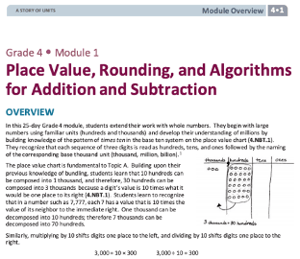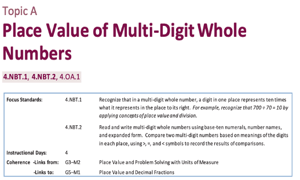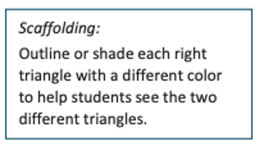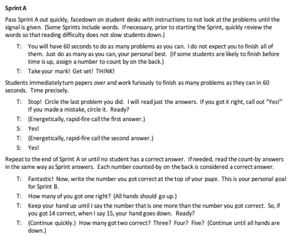Posted in: Aha! Blog > Eureka Math Blog > Implementation Support > Using Your Teacher Edition to the Fullest
When I first started using Eureka Math®, I planned my lessons by opening the Teacher Edition and turning right to Lesson 1. The thing is, my planning wasn’t as effective as it could have been, so I found a better way. Here, I share some of what I learned to help you see the things I initially overlooked in the Eureka Math Teacher Edition.
- Module Overview
- Topic Overview
- Universal Design for Learning (UDL) boxes
- Directions for Administration of a Sprint
- Core Fluency
- Lesson Types
Module Overview (Grades K–12)
The Module Overview is your guide for navigating a module and planning with the coherence of lessons in mind. I didn’t even realize this page existed until my second year using Eureka Math. The Module Overview offers helpful insights about the module and the progression of the lessons, and I wish I had found it sooner. Now, when I start a new module, I read the Module Overview with the following  questions in mind:
questions in mind:
- What is the big picture for student learning in the module?
- What mathematical language will we use?
- What are the connections to foundational knowledge?
- What models, formulas, and strategies are specifically highlighted to enhance student learning?
The Module Overview explains the trajectory of the module and outlines how concepts connect from lesson to lesson. This allows you to make more intentional decisions about pacing because you’ll see how students’ mastery of concepts should develop over time.
Topic Overview (Grades K–12)
At first, I wasn’t exactly sure how to use Eureka Math to support struggling students and to extend the work for successful students. I discovered that the Topic Overview is a great place to get ideas.
 The Topic Overview is located at the beginning of each topic, and it’s exactly what it sounds like—a summary of the topic. The Teacher Edition for Grades K–5 has a section with coherence links that connect to previous and upcoming content. Look at the content in previous modules for remediation and ideas for Tier 2 support. Future modules are a great source of extension activities to support students who need an additional challenge.
The Topic Overview is located at the beginning of each topic, and it’s exactly what it sounds like—a summary of the topic. The Teacher Edition for Grades K–5 has a section with coherence links that connect to previous and upcoming content. Look at the content in previous modules for remediation and ideas for Tier 2 support. Future modules are a great source of extension activities to support students who need an additional challenge.
The Topic Overview gives a clearer picture of the work your students will do, the specific standards they’ll work with, and how the content connects across grade levels.
Universal Design for Learning (UDL) Boxes (Grades K–12)

 You probably need to create scaffolds for students with varying needs. I know I did. Since my students had a variety of needs, I was always looking for ways to create access to the grade-level content. But it was taking a lot of time. Then I noticed the UDL boxes in my Teacher Edition. UDL helps give all students an equal chance of success by changing the way we approach teaching and learning.These boxes include scaffolding suggestions, supports for English learners, and differentiation. The UDL boxes are full of wonderful ideas for ways to customize lessons and meet the needs of diverse learners. Instead of just creating these supports on your own, try the suggestions in the UDL boxes first.
You probably need to create scaffolds for students with varying needs. I know I did. Since my students had a variety of needs, I was always looking for ways to create access to the grade-level content. But it was taking a lot of time. Then I noticed the UDL boxes in my Teacher Edition. UDL helps give all students an equal chance of success by changing the way we approach teaching and learning.These boxes include scaffolding suggestions, supports for English learners, and differentiation. The UDL boxes are full of wonderful ideas for ways to customize lessons and meet the needs of diverse learners. Instead of just creating these supports on your own, try the suggestions in the UDL boxes first.
Directions for Administration of a Sprint (Grades K–8)
I wish I had read about how to deliver a Sprint before I used one with my class for the first time. I used to wonder why there was a Sprint A and a Sprint B. Until I read the Directions for Administration of a Sprint, I didn’t realize that Sprint A and Sprint B were meant to be given back-to-back as timed fluencies. Once I understood the Sprint routine and the goal of student improvement rather than completing every problem, we were able to complete the Sprint process in 8 minutes. I also saw my students’ fluency improve dramatically.
Here are some key points to know about Sprints:
-
 Sprints are designed as practice and build from simple to complex. They build confidence and prepare students for more complicated tasks.
Sprints are designed as practice and build from simple to complex. They build confidence and prepare students for more complicated tasks. - Students have 60 seconds to do as many problems as they can. Most students will not finish. The time limit helps students focus on problems near their individual instructional level.
- Sprints A and B are administered back-to-back with a goal of self-improvement. Motivate students to do their best and compete against their first attempt, not against other students.
In Kindergarten, you’ll find the Building Up to a Sprint Routine in Module 3, Lesson 20, a first Sprint experience in Lesson 21, and the full Directions for Administration of a Sprint in Lesson 25.
Core Fluency (Grades K–5)
 Each elementary grade level has core fluency standards and built-in fluency practices that address fluency goals. Core fluencies come in sets of increasing complexity from set A to set E. I found these to be a useful gauge of student progress because students do not progress to the next core fluency level until they master their current level. The Core Fluency Practice Sets improved my students’ fluency dramatically when we used them consistently. Directions for administering Core Fluency Practice Sets can be found in a Fluency section for each grade as shown in the table. Grade 3 is unique in that core fluencies are incorporated throughout the year in the form of Pattern Sheets.
Each elementary grade level has core fluency standards and built-in fluency practices that address fluency goals. Core fluencies come in sets of increasing complexity from set A to set E. I found these to be a useful gauge of student progress because students do not progress to the next core fluency level until they master their current level. The Core Fluency Practice Sets improved my students’ fluency dramatically when we used them consistently. Directions for administering Core Fluency Practice Sets can be found in a Fluency section for each grade as shown in the table. Grade 3 is unique in that core fluencies are incorporated throughout the year in the form of Pattern Sheets.
|
Kindergarten |
|
Module 4 Lesson 29 |
|
Grade 1 |
|
Module 4 Lesson 23 |
|
Grade 2 |
|
Module 5 Lesson 14 |
|
Grade 3 |
|
Pattern Sheets—All modules |
|
Grade 4 |
|
Module 7 Lesson 2 |
|
Grade 5 |
|
Module 2 Topic B |
The following chart shows how Core Fluencies Practice Sets and Sprints differ.
|
|
Core Fluency Practice Set |
Sprint |
|
Purpose |
Students develop mastery. |
Students demonstrate improvement. |
|
Delivery |
Students work through sets A through E in order, moving to a new set when one is mastered. |
Students work on Sprint A, then immediately on Sprint B, and monitor their improvement. |
|
Complexity |
Complexity builds from set A (least complex) to set E (most complex). |
Complexity builds gradually from the first problem to the final problem in each Sprint. |
Lesson Types (Grades 6–12)
When I first started working with Eureka Math, I taught each lesson the same way. Then I learned that the curriculum in Grades 6–12 has four different lesson types and that the lesson types should inform how I deliver the lessons. Once I fully understood the types of lessons and their purposes, I was able to alter my mode of delivery to enhance each type of lesson. For example, I used talk moves during Socratic lessons to foster student discourse. Exploration lessons were opportunities for my students to wrestle with complex mathematical ideas and have the freedom to make mistakes.
The lesson types are noted on the Topic Overview page following the title of the lesson. Here is a description of each type of lesson you’ll see.
|
|
Problem Set Lesson |
The teacher and students work through examples and complete exercises to develop or reinforce a concept. |
|
Socratic Lesson |
The teacher leads students in a conversation to develop a specific concept or proof. |
|
|
Exploration Lesson |
Students work independently or in small groups on a challenging problem followed by a debrief to clarify, expand, or develop math knowledge. |
|
|
Modeling Cycle Lesson |
Students practice all or part of the modeling cycle with real-world or mathematical problems that are either well- or ill-defined. |
Submit the Form to Print

Jessica Jeffers
Jessica Jeffers is a Eureka Math implementation leader. She's a former Grade 5 teacher and math coach.
Topics: Implementation Support











